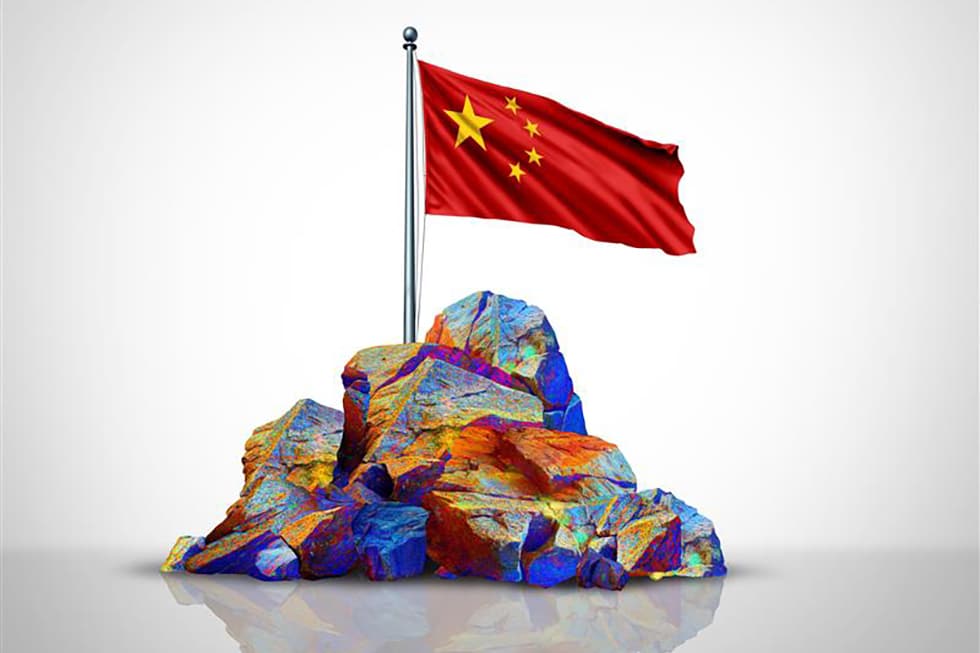Once obscure and overlooked, rare earth elements (REEs) are now at the heart of the 21st-century technological revolution. From precision-guided missiles and electric vehicles to wind turbines and smartphones, REEs power the critical systems that define our digital and low-carbon future. As the global shift toward electrification and renewable energy accelerates, demand is spreading across nearly the entire Periodic Table, driven by the unique, irreplaceable functions of these often-unconventional materials. At the center of this transformation stand the 17 distinct REEs, indispensable to the modern world yet challenging to secure.
Rare earths (the general term encompassing all REEs) are typically divided into light and heavy categories. While light REEs like cerium and lanthanum are more abundant, it is the heavy ones — dysprosium, terbium, neodymium and others — that are essential for permanent magnets used in high-temperature environments, such as electric vehicle motors, fighter jets and missile guidance systems.
Magnet strength declines significantly at high temperatures if lighter REEs are used alone. Thus, high-density rare earths must be mixed in to maintain performance. China controls nearly 99% of heavy REE processing, not just because of resource abundance, but because it has developed and protected its technical edge in separation processes. Moreover, Chinese firms often operate at a loss but are supported by state subsidies, which allows them to drive out global competition.
China’s rare earth dominance and the strategic supply chain asymmetry
Despite large-scale investment — over $439 million from the Department of Defense since 2020 — the United States remains dependent on Chinese magnets. For example, MP Materials, the leading US producer, plans to produce just 1,000 metric tons of neodymium-boron-iron (NdFeB) magnets annually by 2025. That is less than 1% of China’s 2018 output.
Even promising breakthroughs, such as USA Rare Earth’s 99.1% pure dysprosium oxide sample in early 2025, remain at the pilot stage. Commercial viability is years away. In the meantime, Chinese production continues to scale. In 2024 alone, China produced an estimated 300,000 tons of NdFeB magnets. The US’s goal of an independent REE supply chain by 2027 remains aspirational, not assured.
China’s advantage lies in its vertical integration, from mining to refining to magnet production. It has built and subsidized its REE ecosystem through environmental externalization, industrial policy coherence and technological investment. In doing so, it has created a monopolistic grip on the midstream and downstream segments of the supply chain. This control gives Beijing strategic leverage, which it has exploited several times. In 2010, Beijing cut off exports to Japan over maritime disputes, and in 2023–2024, it implemented licensing restrictions to retaliate against US semiconductor export controls and tariffs. These measures have not been wholesale bans but targeted, calibrated interventions designed to inject uncertainty, pressure adversaries and reassert industrial dominance.
The nature of this dominance reveals a deeper structural asymmetry: China is able to play a long game, enabled by centralized political authority and strategic continuity. Democracies, meanwhile, struggle to maintain long-term consistency across administrations. In game-theoretic terms, China acts as a high-commitment actor in a repeated, asymmetric game.
Without equivalent institutional coherence, the US and its allies are consistently reacting to Beijing’s initiatives rather than shaping the trajectory of the REE landscape.
Rare earths and US tariffs
In response to sweeping US tariffs in 2025 — up to 145% on Chinese imports — Beijing strategically restricted the export of several rare earths, including dysprosium and neodymium. This move intensified concerns across global industries, with automakers and defense contractors warning of severe production disruptions due to limited alternative suppliers.
The tit-for-tat escalated until the two parties announced a provisional deal in London. China agreed to resume shipments of rare earths and magnets to the US in exchange for tariff reductions to 55% and the easing of restrictions on Chinese students studying in America. US President Donald Trump claimed victory, stating that the “full magnets, and any necessary rare earths, will be supplied, up front, by China.” However, details remain vague and enforcement mechanisms unclear. Both sides characterized the deal as a “framework” still awaiting final approval from Chinese President Xi Jinping and Trump.
Despite this temporary truce, the rare earth dispute underscores the strategic risks of supply chain concentration. The US continues to rely heavily on China for processed REEs, especially heavy rare earths critical to defense. Unless structural diversification is achieved through domestic production, allied partnerships or technological alternatives, the geopolitical leverage China holds through its dominance in rare earths will remain a persistent vulnerability for the US and its allies.
US vulnerability and the emerging strategic response
Recognition of this strategic vulnerability has grown in Washington, especially given defense-sector dependencies. An F-35 fighter jet requires over 900 pounds of rare earths; a Virginia-class submarine demands more than 9,000 pounds. Yet despite years of warnings, the US remains almost entirely dependent on Chinese REE refining and magnet production. While upstream mining projects exist, such as Mountain Pass in California, the absence of domestic separation capacity means that most US-extracted ore is still shipped to China for processing. In response, the US has initiated a patchwork strategy aimed at diversifying supply.
However, Greenland’s mining promise is constrained by structural limitations: limited infrastructure, complex permitting requirements and indigenous land rights. Moreover, mining in Arctic conditions is capital-intensive and environmentally risky. To succeed, US-led efforts must not only provide financial support but also demonstrate political maturity and long-term commitment. Greenland is, in effect, a test of whether democracies can engage in high-stakes resource development without compromising transparency or environmental integrity. Its trajectory will reveal whether values-based industrial policy can function at scale in strategic sectors.
Japan’s deep-sea initiative and the role of scientific autonomy
Japan’s experience offers a parallel yet distinct response to Chinese dominance — one rooted in scientific capacity and technological self-sufficiency. Following China’s 2010 embargo, Tokyo moved rapidly to secure alternative supply lines. It established recycling capabilities from electronics, formed bilateral mineral partnerships with countries such as Vietnam and India and launched intensive research and development (R&D) into seabed resource potential.
These efforts culminated in a landmark 2024 discovery: Japan discovered over 230 million tons of cobalt- and nickel-rich manganese nodules within its exclusive economic zone near Minamitori Island. China is preparing to test mining operations for rare metals in the Pacific Ocean, in waters near Japan’s island. This signals a bold move into seabed resource competition in the region.
While these nodules do not contain large concentrations of traditional rare earths, their richness in battery-critical minerals, namely cobalt and nickel, and the heavy REEs could dramatically enhance Japan’s strategic position in the broader clean energy supply chain. Equally important is the technological accomplishment of accessing resources at depths of 5,200–5,700 meters. Only a handful of countries possess the capability to conduct extraction operations at such depths with precision and environmental control. Japan’s pilot project, slated for initiation in 2025, aims to extract up to three million tons of nodules annually — potentially enough to meet its battery mineral needs for decades.
What makes Japan’s approach noteworthy is not only its innovation but its philosophical divergence from China’s model. Japan is pursuing resource security through scientific rigor, environmental standards and alliance-building rather than through monopolistic or coercive tactics. If its deep-sea initiative succeeds, it could become a model for how technologically advanced democracies can secure strategic resources without replicating the extractive externalities that have defined China’s dominance.
Allied coordination, fragmentation and the limits of decentralized strategy
Despite individual national efforts, fragmentation remains a persistent obstacle to building a resilient non-Chinese REE supply chain. Australia, for example, hosts the Browns Range project, which is one of the most promising sources of dysprosium outside China. Japan and Vietnam have increased collaboration on REE separation and materials R&D, and the European Union has launched its Critical Raw Materials Act to spur investment. Yet even the leading Western processor, Lynas Rare Earths, still sends intermediate products to China for final-stage processing. As China tightens export controls, Lynas’s shares surge, which reflects investor anticipation that global automakers may seek more secure, non-Chinese alternatives amid mounting supply chain vulnerabilities.
The underlying problem is the lack of full-cycle infrastructure coordination. A strategic REE supply chain requires not only mining capacity, but also processing facilities, magnet manufacturing plants, recycling systems and logistics integration across multiple geographies. The current system remains siloed, underfunded and inefficient. Moreover, without harmonized standards and cross-border investment frameworks, allied countries risk duplicating efforts or falling prey to lowest-common-denominator policies — compromise policies that reflect the minimum agreement among allies. These compromises often sacrifice ambition, efficiency or strategic coherence for the sake of consensus.
What is required is a high-level governance mechanism, possibly embedded in the Quad, Five Eyes or a NATO-adjacent security structure, to formalize critical minerals cooperation. This should include pooled investment funds; technology-sharing agreements; Environmental, Social and Governance standards alignment and industrial policy synchronization. In an age of resource competition, no single democracy can independently match China’s vertical integration. Only through coordinated decentralization with shared institutional scaffolding can the West generate sufficient strategic redundancy and resilience.
Political time horizons and the future of industrial strategy
The rare earths challenge lays bare a fundamental difference in political time horizons between autocracies and democracies. China’s one-party system enables decades-long planning, patient capital deployment and a stable industrial policy trajectory. The US, by contrast, suffers from electoral discontinuities, congressional gridlock and an industrial base shaped by short-term shareholder pressures.
To bridge this institutional gap, democracies must develop new mechanisms that insulate critical minerals policy from political volatility. This could involve establishing independent national critical minerals authorities with multi-cycle mandates, creating bipartisan legislation for industrial strategy permanence or structuring supply chain agreements through treaties that bind successor governments. Without such reforms, the long-term credibility of Western REE strategy will remain vulnerable to disruption.
The rare earths struggle is not simply about materials — it is about institutional capacity and statecraft. It is a contest over who gets to shape the technological platforms of the future, under what rules and with what environmental and political tradeoffs. China has shown that industrial strategy can be wielded as a tool of global influence. The question now is whether democracies can build equally powerful yet norm-conforming strategies in return.
The map of rare earth production is being rewritten. Whether it reflects a pluralistic, resilient system or one beholden to coercive concentration depends not just on markets or geology, but on whether the political systems of the democratic world can adapt to the strategic logic of the 21st century.
[Lee Thompson-Kolar edited this piece.]
The views expressed in this article are the author’s own and do not necessarily reflect Fair Observer’s editorial policy.
Support Fair Observer
We rely on your support for our independence, diversity and quality.
For more than 10 years, Fair Observer has been free, fair and independent. No billionaire owns us, no advertisers control us. We are a reader-supported nonprofit. Unlike many other publications, we keep our content free for readers regardless of where they live or whether they can afford to pay. We have no paywalls and no ads.
In the post-truth era of fake news, echo chambers and filter bubbles, we publish a plurality of perspectives from around the world. Anyone can publish with us, but everyone goes through a rigorous editorial process. So, you get fact-checked, well-reasoned content instead of noise.
We publish 3,000+ voices from 90+ countries. We also conduct education and training programs
on subjects ranging from digital media and journalism to writing and critical thinking. This
doesn’t come cheap. Servers, editors, trainers and web developers cost
money.
Please consider supporting us on a regular basis as a recurring donor or a
sustaining member.
Will you support FO’s journalism?
We rely on your support for our independence, diversity and quality.








Comment